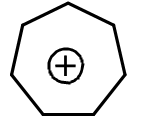Chemistry-
General
Easy
Question
In the following reactions:
I) 
II) 
the rate of reaction of (I) and (II) are same. Bothreactionsproceed by which mechanism
- E1
- E2
- E1cB
- Anti-elimination
The correct answer is: E1
Related Questions to study
Chemistry-
In the reaction of p-chlorotoluene with in liquid
in liquid  , the major product is:</span
, the major product is:</span
In the reaction of p-chlorotoluene with in liquid
in liquid  , the major product is:</span
, the major product is:</span
Chemistry-General
Chemistry-
Which compound does not react with PCI5?
Which compound does not react with PCI5?
Chemistry-General
Chemistry-
In the following reaction:

By which mechanism does the reaction proceed?
In the following reaction:

By which mechanism does the reaction proceed?
Chemistry-General
Chemistry-
Product on monobromination of this compound is

Product on monobromination of this compound is

Chemistry-General
Chemistry-
In bakelite, the rings are joined to each other through:
In bakelite, the rings are joined to each other through:
Chemistry-General
Chemistry-
Schiff's reagent is
Schiff's reagent is
Chemistry-General
Chemistry-
Propyl ester reacts with isopropyl magnesium bromide to give 2° alcohol
 The ester is:
The ester is:
Propyl ester reacts with isopropyl magnesium bromide to give 2° alcohol
 The ester is:
The ester is:
Chemistry-General
Chemistry-
Which of the following on reaction with acetylene ( ) produce gas(es)?
) produce gas(es)?
I) K in liquid NH3
II) 
III) 
IV) 
Which of the following on reaction with acetylene ( ) produce gas(es)?
) produce gas(es)?
I) K in liquid NH3
II) 
III) 
IV) 
Chemistry-General
Chemistry-
When but-2-yne is treated with dil. H2SO4/HgSO4, the product formed "is:
When but-2-yne is treated with dil. H2SO4/HgSO4, the product formed "is:
Chemistry-General
Chemistry-
 The decreasing order of the rate of the above reaction with nucleophile (
The decreasing order of the rate of the above reaction with nucleophile ( ) (A) to (D) is:
) (A) to (D) is:

 The decreasing order of the rate of the above reaction with nucleophile (
The decreasing order of the rate of the above reaction with nucleophile ( ) (A) to (D) is:
) (A) to (D) is:

Chemistry-General
Chemistry-
Which of the following is the correct order of stability of the given compounds?
I) 
II) 
III) 
Which of the following is the correct order of stability of the given compounds?
I) 
II) 
III) 
Chemistry-General
Chemistry-
Chemistry-General
Chemistry-
Which of the following does not react with NaHSO3 ?
Which of the following does not react with NaHSO3 ?
Chemistry-General
Chemistry-
 (A) is:
(A) is:
 (A) is:
(A) is:
Chemistry-General
Physics-
Statement- I : The distance covered by a body is given by  , where the symbols have usual meaning. Statement-II : We add quantities, subtract or equate quantities with the same dimensions
, where the symbols have usual meaning. Statement-II : We add quantities, subtract or equate quantities with the same dimensions
Statement- I : The distance covered by a body is given by  , where the symbols have usual meaning. Statement-II : We add quantities, subtract or equate quantities with the same dimensions
, where the symbols have usual meaning. Statement-II : We add quantities, subtract or equate quantities with the same dimensions
Physics-General





